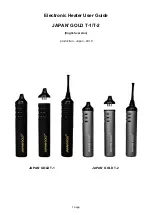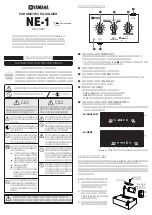
15
THEORY OF OPERATION
The E and F signals are amplified and subtracted. This produces the tracking error signal
TEAO (U501, pin 7 ). The F channel’s gain is adjusted by E-F balance potentiometer R506.
The TEAO signal is used by the anti-shock circuit, the track jump detection circuit, and the
tracking servo. The track jump detection output is sent to U502 on the TES line (U501, pin 47).
R510, which is connected to TPA+ (U501, pin 13 ), adjusts the tracking gain. This signal is
amplified and filtered. It then appears as an output on TPAO (U501, pin 15). R511 adjusts the
tracking offset . The TPAO signal is further amplified and filtered. It then appears as an output
on TDO (U501, pin 21). This signal is fed to U503. U503 generates the complementary out-
puts (U503) that are used to actuate the tracking coil (P502, pins 6 and 7).
The TDO signal is also used as the input for the sled servo. This signal is filtered and fed to the
sled servo amplifier on SLEQ (U501, pin 20). This signal is amplified and is then added to the
FEED signals from U505. The result appears on SLDO (U501, pin 33). This signal is fed to
U504. U504 generates the complementary outputs (pins 11 and 14) that are used to drive the
sled motor (P503, pins 5 and 6).
The Constant Linear Velocity (CLV) servo is regulated by comparing the playback speed to a
FIXED reference frequency in U502. The error signal appears at U502, pins 10 and 11 (CLV+
and CLV-). These signals are subtracted and the difference appears on SPD (U501, pin 29).
The SPD signal is filtered and amplified. It then appears at the output on SPDO (U501, pin
31). This signal is fed to U504. U504 generates the complementary outputs (pins 3 and 6) that
are used to drive the disc motor (P503, pins 1 and 2).
U501 regulates the laser power by monitoring the MD input (P502-3). This signal is compared
to a reference to generate the proper drive signal on LDD (U501, pin 74). This signal biases
Q501. Q501 drives the laser diode output LD (P502-1). U501’s main DC reference voltage is
Vref3 which appears on pin 9. This voltage is nominally 4V.
The VCO is the final function contained in U501. The VCO is used by U502 for EFM demodu-
lation. The PDO output signal (U502, pin 4) is filtered and amplified by U501. In turn, this
output appears on VCOC (U501, pin 59) This is the VCO control voltage input. The nominal
VCO free-run frequency is 8.64MHz and is set by R558. The VCO also requires a 16.9344MHz
clock input from U502. This input appears on CLK (U501, pin 62). The VCO output appears at
VCOO (U501, pin 60). This signal is buffered by U502. The buffered output appears on AO
(U502, pin 2). The VCO output is divided by 2 in U502. In turn, its output appears on PCK
(U502, pin 18), which is 4.32MHz.
The DSP clock is derived from a 16.9344MHz crystal oscillator (X501). However, this oscillator
is normally turned off by U505. It is only switched on during focusing and when a disc is play-
ing. U502 receives its EFM input from U501 on EFMIN (pin 8). This signal is sliced, EFM
demodulated, and CIRC decoded. The digital audio output signal is sent serially to U506 on
the LRCLK, DFOUT and DACLK lines (U502, pins 33, 35, and 36).
U502 receives servo control commands from U505 on the serial bus (U502, pins 51, 53 and
54). These commands are translated to appropriate control signals for U501 for focusing, disc
start, disc stop, disc braking, and track jumps. The focus servo is controlled by the FOCS and
FST outputs. The CLV servo is controlled through the CLV+ and CLV- lines. The tracking
servo is controlled by the TOFF, TGL, and THLD outputs. Track jumps are created by signals
on the JP+ and JP- lines. Track jump detection is based on signals from U501 on the HFL and
TES inputs.
Summary of Contents for Lifestyle CD5 Series I
Page 6: ...5 Figure 1 CD5 Block Diagram Sheet 1 of 2...
Page 7: ...6 Figure 2 CD5 Block Diagram Sheet 2 of 2...
Page 19: ...18 See Figure 6 for a side view of this assembly Figure 3 Labelled Exploded View...
Page 30: ...29 Figure 12 Passive Filter Network and Test Setup...
Page 33: ...32 Figure 13 Digital PCB Adjustment Locations...
Page 36: ...35 Figure 14 Exploded View...
Page 62: ...61 T303 AM Front End Tuning Module INTEGRATED CIRCUIT DIAGRAMS TUNER FM Front End Module...
Page 64: ...63 U402 Microcontroller 68HC05C12 INTEGRATED CIRCUIT DIAGRAMS...
Page 65: ...64 U501 ASP LA9210M INTEGRATED CIRCUIT DIAGRAMS...
Page 66: ...65 U502 DSP LC7867 INTEGRATED CIRCUIT DIAGRAMS...
Page 67: ...66 INTEGRATED CIRCUIT DIAGRAMS U505 Microcontroller 68HC05P7 U506 D A Converter LC7883M...
Page 69: ...68 Figure 18 RC5 Schematic...
















































